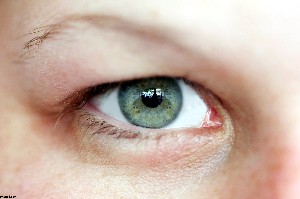Nutrionists at Drexel University in Philadelphia and St. Luke’s/Roosevelt Hospital Center in New York showed the ability of a routine ophthalmology test to indicate a high pleasure response to food, a potential tool for analyzing food addictions and obesity therapies. The team led by Drexel’s Jennifer Nasser published their findings online last week in the journal Obesity (paid subscription requried).
Nasser and colleagues borrowed a tool from ophthalmology called electroretinography that measures the electrical response of the eye’s light-sensitive cells that are part of the retina. The test is usually administered to detect disorders of the retina.
In this proof-of-concept study, the researchers used electroretinography with nine subjects to indicate increases in dopamine in the retina. Dopamine is a naturally occuring neurotransmitter chemical that helps control pleasure and reward centers in the brain. Activation of the optical nerve in response to light exposure also releases dopamine, which can then be tracked by the electrical signals measured with electroretinography.
Nasser’s team gave the subjects a piece of chocolate brownie at the same time of a flash of light during the electroretinography test. All participants were overweight, but had no eating disorders, and fasted for four hours before the test.
The results showed a strong spike in electrical signals when fed the brownie. The sharp increase in electrical activity, say the researchers, was similar to the reaction of the subjects given the drug methylphenidate to provoke a dopamine response. Methylphenidate, marketed as Ritalin by Novartis, is a central nervous system stimulant prescribed to control symptoms of attention deficit hyperactivity disorder.
Using plain water as a control substance, the researchers found a much lower response in electrical activity. The subjects took the electroretinography test with methylphenidate on a separate day from the food stimulus test.
Electroretinography tests, say the researchers, are reimbursed by Medicare at about $150 per session, with each session generating some 200 scans in two minutes. Positron emission tomography (PET) scans that can measure dopamine responses from the brain, by comparison, cost about $2,000 and can take about an hour.
The electroretinography technique, say the researchers, if validated in studies with larger samples, offers another tool for food science studies and diagnosing food addictions.
Read more:
- Asthma Drug Reveals Potential as Diabetes, Obesity Treatment
- Mobile App and Classes Help Obese People Lose Weight
- Color Codes, Eye-Level Positions Boost Healthy Food Choices
- U.S. Obesity Rate Expected to Rise to 42% by 2030
- European Project to Develop More Satisfying Food
* * *


 RSS - Posts
RSS - Posts
[…] Inexpensive Eye Test Measures Pleasure Response to Food […]